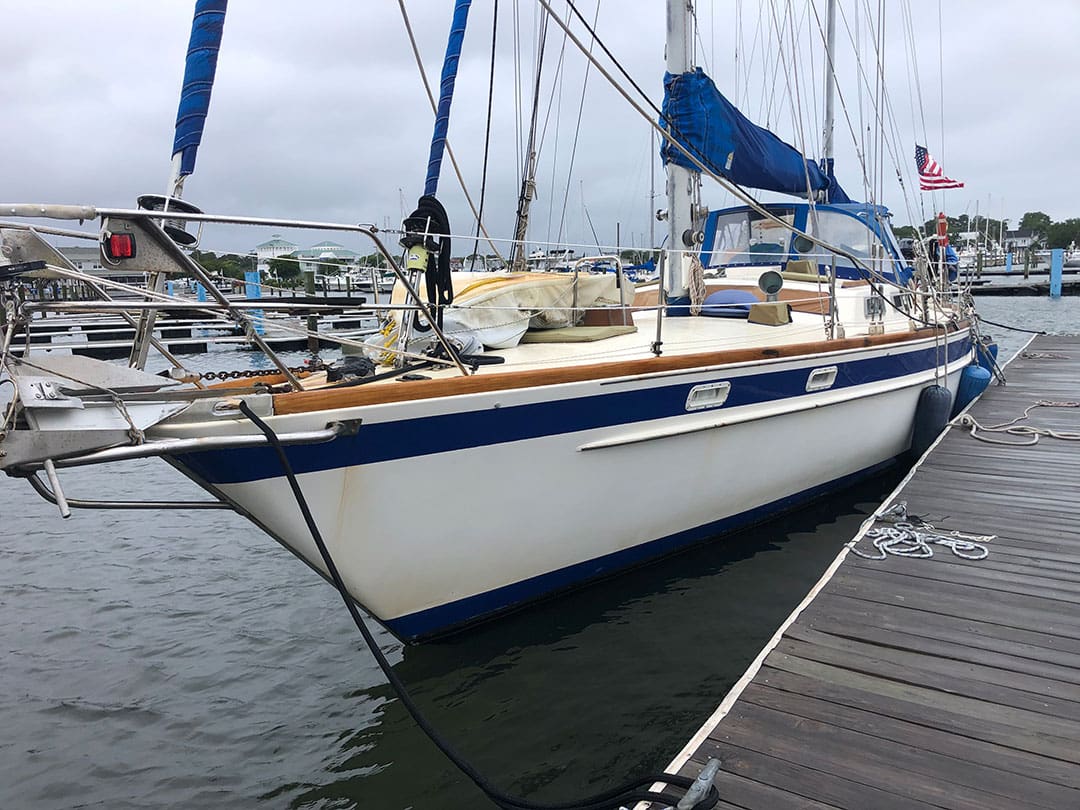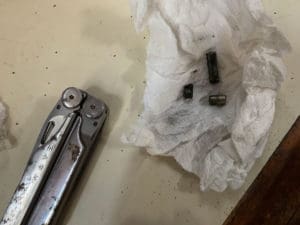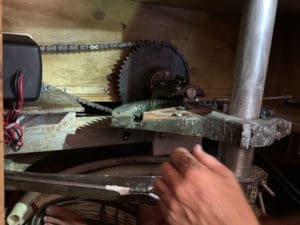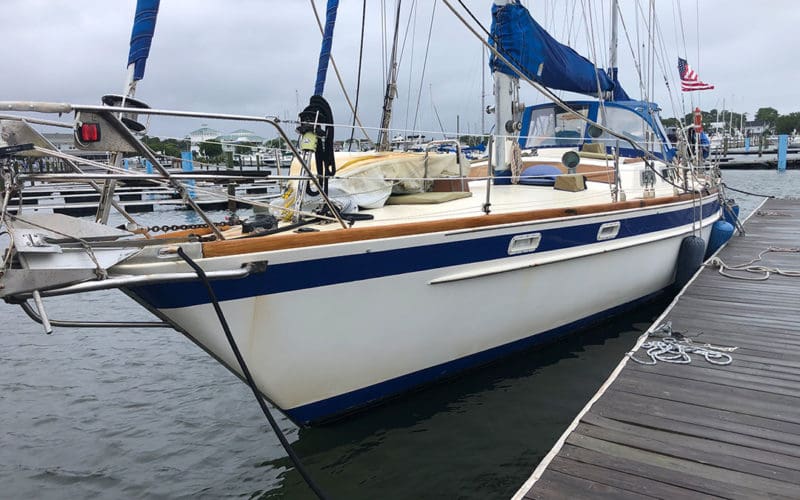An autopilot failure forces an offshore crew to improvise

We had just entered the Gulf Stream heading north from Palm Beach with some 1,100 nautical miles to Martha’s Vineyard when our autopilot failed. Even though we were in settled conditions, we instantly knew the gravity of the issue – that without a reliable repair we would need to turn back or face more than a thousand miles of hand steering including hundreds of miles in the stream, not a pretty prospect, especially with just three on board.
Sea Witch is John Stephenson’s 53-foot Pearson ketch. She displaces more than 40 tons and is a beautiful, solid offshore dream, able to eat up rough conditions with aplomb, while doing surprisingly well in light air given her size. Besides John and myself, Brian Halderman, a friend of John’s from Boston, was also aboard. Brian and I had joined Sea Witch in Lake Worth to help John sail back to his home grounds of Martha’s Vineyard, where he runs a successful charter business with Sea Witch.
The symptoms of our problem were clear enough. Under a jib and jigger rig in moderate conditions, we were loping along at six knots when the autopilot (a Raymarine ST7001) would shut down and stop steering, with the fault, DRIVE, coming up on the display. We tried rebooting several times, along with course changes and other efforts, all to no avail. So was it the drive unit head causing the fault, or the drive unit detecting a mechanical problem? We had to investigate – and pronto.
There is nothing like a boat owner who knows every inch of his vessel, and all her strengths and any weaknesses. John is that guy and more. He is also one of those sailors who can just plain fix things. And he has no particular specialty; he just fixes anything that needs it.
“Is the drive unit reachable and easy to see?” I asked. John gave me a smile and a thumbs up, and 10 minutes later we had disassembled the bulkhead in Sea Witch’s aft cabin, revealing the ST7001 drive unit and wiring, along with full access to the boat’s rack and pinion steering mechanics, including rudder post, sprocket and chain, quadrant and drive gear. We posted Brian at the helm with a VHF tuned to channel 17, and we had the same below for precise communication. Our initial hope was that by simple observation we might notice some causal factor when we had Brian engage the pilot, and again when we had him hand steer. We needed to take care with our commands to Brian at the helm, because John’s hands and legs were periodically in harm’s way.
Nothing apparently amiss
At first we saw nothing amiss, whether the autopilot unit was steering or Brian was moving the wheel. The electronic drive unit looked fine and had been recently replaced. All its wiring and terminals looked fine. We turned our attention to the drive unit mechanics. As a diagnostic test, we had Brian alternately engage then disengage the autopilot, while keeping as straight a course as possible. With the autopilot engaged, and waiting for it to fail, we saw a slight difference in the rotation of the sprocket and the drive gear, which should move in exact tandem. So our first hint of trouble was potential slippage between drive gear and shaft. For test two we had Brian disengage the autopilot and hand steer with no movement of the wheel, and therefore as close to a stationary drive assembly below. John grasped the sprocket with both hands and twisted hard, and it turned, but the main drive gear did not fully match the turn! This was a defining moment in the diagnosis of our problem and why the ST7001 would sense a drive failure and shut down. But now what?
There was a lot of black grease hindering our view of the main drive gear. Removing much of it revealed a second anomaly: there appeared to be a slightly raised quarter inch round “post” between the gear teeth. Probing it, John decided it had to be one end of the keyway pin joining the gear to the drive shaft, thus marrying the sprocket, quadrant, drive gear and shaft. But where was the other end, and was it also raised, or flush to the gear as we would expect? We tried a 180 degree turn of the helm but still could see nothing and could not maintain that course. So, although we had a growing sense we were on to something important, it all had to come out and be taken apart. This was a critical moment as the old bromide, “first, do no harm” was ringing loudly. John, however, was undaunted. We had Brian again freeze the helm while we removed sprocket, chain, drive gear and the wishbone brackets holding all together. Some parts we set aside, but the main drive gear assembly went straight to the engine room, where John has a hefty vise installed.

Extracting the pin
With all under our control, we could plainly see that the raised post had an opposite end 180 degrees on the gear, and that it rode flush between the gear teeth – just what we expected. It had to be a keyway that ran straight through the gear and shaft, locking them together. And we knew if one moved without the other in perfect tandem, there was mischief within the keyway, likely the pin itself. With a pair of needle-nose pliers John was able to extract the raised pin like a bad tooth, and it told us volumes. There was clear evidence of metal fatigue and that the removal of that small portion of the pin without the rest meant the whole keyway was compromised.
“We need to punch out the rest,” I said (cementing my role as the articulator of the obvious). But how? The punch in this case needed to be round, not tapered, and quarter inch in diameter. We could not risk getting anything stuck in the keyway.
John has Sea Witch equipped like a Snap-On Tools Truck, and a good thing, too. In a flash he was brandishing his center punch kit, all round, with a beautiful quarter inch unit that fit the keyway like a glove. But no matter how we tapped or struck the punch, we could achieve no movement of the rest of the pin. We were stumped. Brian was steering faithfully and we were getting deeper into the Gulf Stream, making any return problematic.

An etched mark
Then, after a little more degreasing and inspection, behold: we spied a scribe mark etched on the shaft that looked like an alignment guide for the drive gear and shaft. John lined them up and, tap, tap, tap, out popped the keyway pin – in three more pieces!! We had our cause, and we were ecstatic!!
But there was still a long way to go to morph our diagnosis into a real cure. First there was the construction and placement of a new keyway pin, one that would have a friction fit and not pop loose under stress. It did not take long for us to realize that the punch that fit so well was our best bet. Out came the calipers and fine-tooth hacksaw, and with the alignment still fixed and true, John gently tapped home the new pin into its keyway, with plenty of friction and just an insurance dab of Locktite.
Reassembly was a cakewalk after all our previous work, and the moment of truth came after the reassembly was complete and all snugged down. “Brian, reengage the autopilot and come to course.” John and I watched like two hawks as the sprocket, chain, quadrant, drive gear and shaft began their designed choreography without a fault, tight as a drum and with the precision of a (greasy) Swiss watch.
We rode the Gulf Stream all the way to Hatteras and beyond, some 800 nautical miles with autopilot perfection. The feeling of satisfaction was immense, for with that incredible repair at sea our passage was preserved.
The only thing we could not fix was the weather, which turned nasty and forced us into Little Creek at the mouth of the Chesapeake. But that is a different story, and besides, the autopilot steered the whole way!
Rick Meisner, a retired corporate executive, sails his Valiant 42, WildHorse, out of Watch Hill, R.I.

